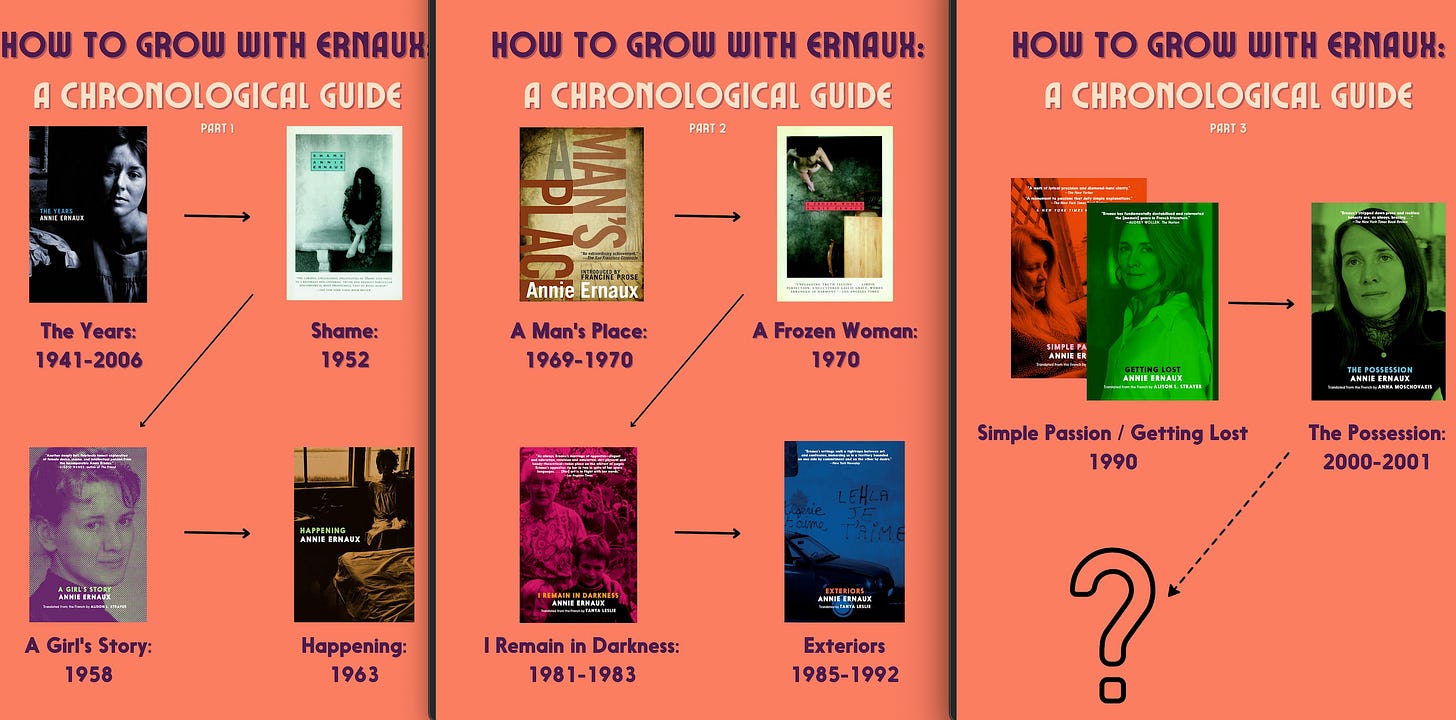Beginning
A life, one word at a time
I’ve been meaning to read through Annie Ernaux’s work for a long while now, but with the recent Nobel win and a personal need for some one-sit-reads, I thought it would be worthwhile to document my journey.
Ernaux’s body of work consists of three novels and twelve works of nonfiction. While her writing precedes the term/notion of “autofiction” I would allow it as a useful lens through which to understand her work. Ernaux’s twelve nonfiction titles can be understood as one long novel—that of Annie Ernaux’s life. Rather than a straightforward, memoiresque narrative, Ernaux’s narrative jumps around time and space, revisiting the same moments from different points in her life and often disregarding the personal in order to appreciate the material. This puts her in conversation with another giant of autofiction, Karl Ove Knausgaard. Knausgaard’s six part My Struggle series performs a similar feat in depicting a life lived. Like Ernaux, Knausgaard’s writing also occasionally disregards the personal for the material, as seen in his Seasons Quartet. It is no coincidence that both of these writers are influenced by Marcel Proust: autofiction seems to be his modern literary legacy.
But rather than go on about autofiction and larger literary movements, I’d prefer to approach this style by sinking into it. Knausgaard’s books invite this, but only within the reading of a single book. His hundreds upon hundreds of pages demand a presence that feels almost as long and steady as lived reality. Ernaux, on the other hand, seems to have perfected the art of brevity. Her brevity is even more intriguing when paired with the weighty subject matter her books cover: abortions, Alzheimer’s, affairs, etc.
All of this to say: I’m curious about the experience of microdosing a life. In this blog I’ll be posting my thoughts and reflections as I read through her work. Ernaux’s US publisher, Seven Stories Press, has shared a helpful guide that places her nonfiction in chronological order.
Confusingly, A Woman’s Story is missing from this list. Also, while The Possession is listed as fiction elsewhere, it is placed here. Regardless, A Woman’s Story and A Man’s Place are meant to be read together, so that is an easy addition. And while I do plan to get to her fiction at some point, it’ll probably be after I’ve finished her nonfiction first.
Going off of this guide, I’ll be starting with Shame. The Years is frequently listed as the best starting place for her work, even by Ernaux herself, however I have been struggling with it over the past two days. It is an outlier in her work in its disregard of the personal for the societal: The Years is the story of a generation told by that generation, channeled through Ernaux. While often beautiful in itself, I’m more excited to delve into her more personal writing. I imagine I’ll slowly read The Years as I read through her other books, as a way to provide a spatial and temporal backdrop to the life being lived on the pages.
Expect a post about Shame and/or The Years sometime soon. If you’ve read this far I appreciate you and hope you join me on this expedition into the works of one of our great living artists.



